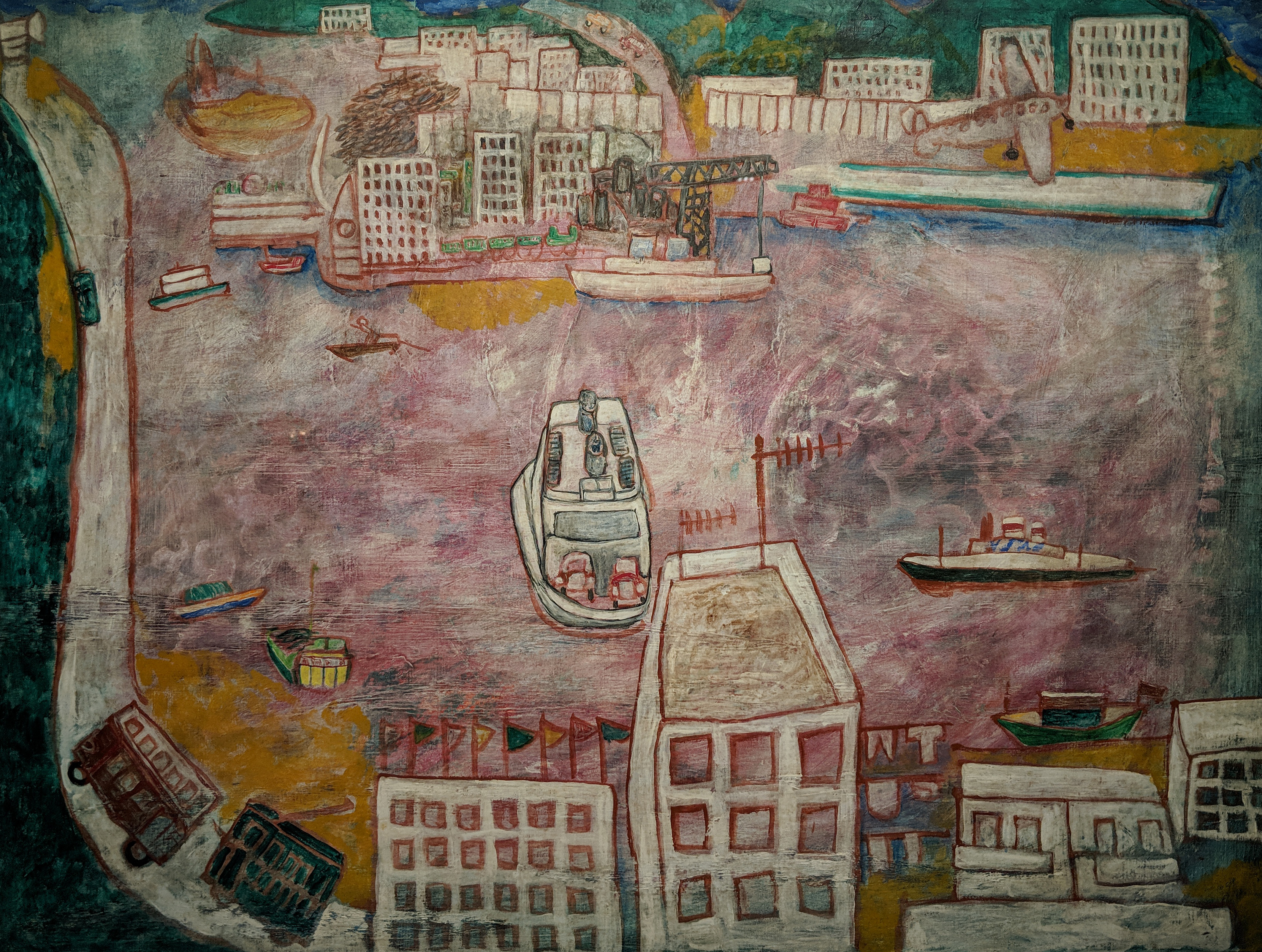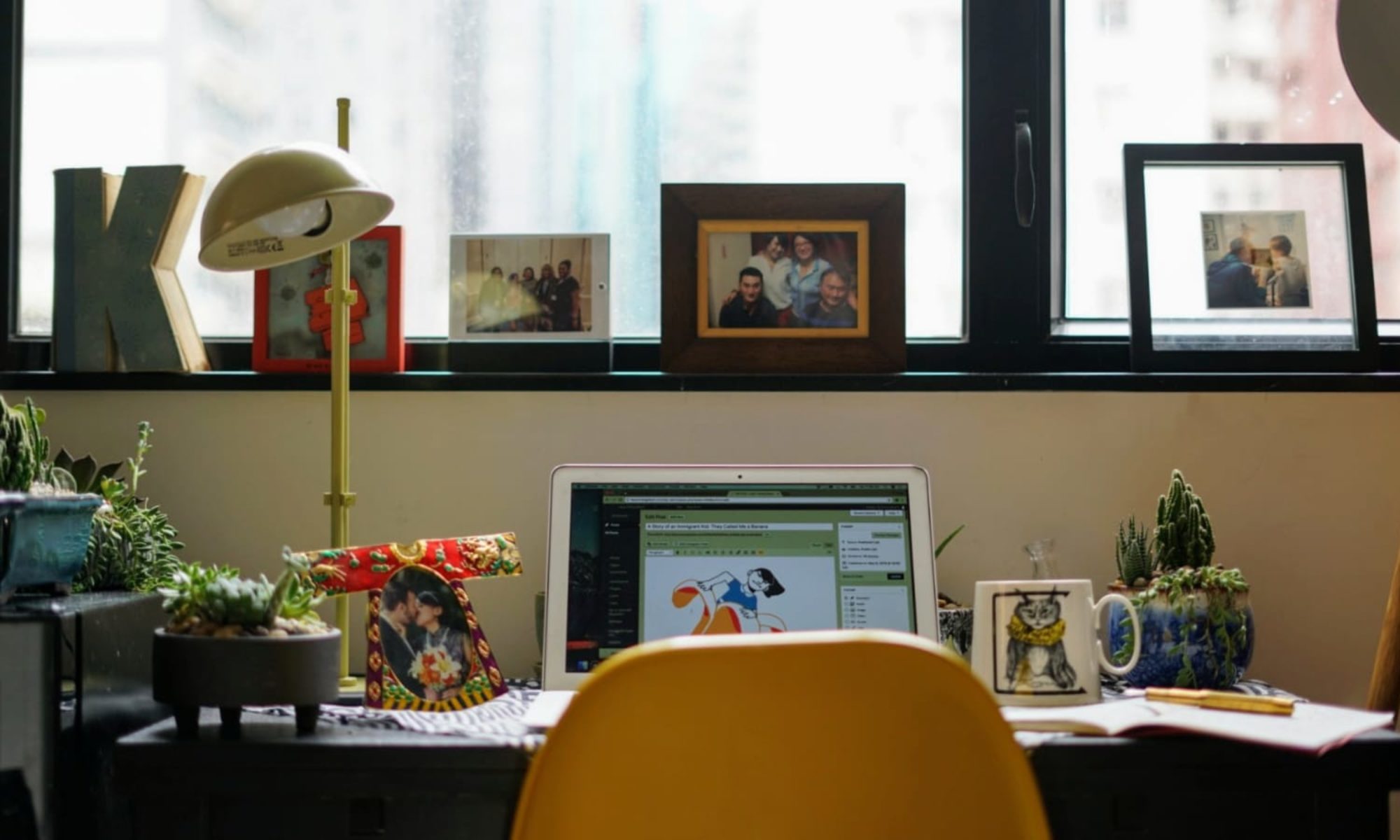Studying an acrylic painting of green shrub and concrete, Dewey Punk Pickles knows right away what she’s looking at—a pathway in Wan Chai she passes by during her morning runs to Victoria Harbour. Yeung Tong Lung’s brush strokes remind her of Cézanne’s obsessive and repetitive dabbing of paint. However, unlike Cézanne, who took up to 100 work sessions to complete a still life, Dewey doubts this artist had put in as much effort.
Dewey is at Wan Chai Grammatica: Past, Present, Future Tense, an exhibition celebrating the 40th anniversary of the Wan Chai Arts Center, Hong Kong. Lately, she has attended many shows and openings to enhance her skills as an art writer. For a Hong Kong-based writer who doesn’t want to work in finance or PR; art writing is her best bet.
As a Wan Chai resident of almost seven years, Dewey is interested in how artists see Hong Kong from the past, present, and future. Looking at an acrylic painting by Galylord Chan, she recognizes that this is an image of Vicotria Harbour of Old Hong Kong— the low-rise, not-skyscraper buildings, the old-timey clothes hanging to dry, and the airplane flying near the mountains on the Kowloon side where the old Kai Tak airport used to be. Though she wasn’t alive in Hong Kong during that time, she’s seen enough of Fan Ho’s photographs to get a sense of what Hong Kong was like in the past.
Chan’s painting looks as though the viewer is viewing at the harbor from the mountains, and the artist uses child-like lines to render the cityscape, evoking a sense of innocence. However, there is a depth to it too, like the way the artist illustrates the stacking of concrete buildings in Kowloon to show its population density. Also, by placing a ferry in the middle of the painting, the artist highlights the importance of ferries in Old Hong Kong—before the MTR (the reliable and inexpensive transportation system of Hong Kong), people relied on ferries to get from Hong Kong Island to Kowloon and vice versa. These days, the Star Ferry that takes passengers from Wan Chai to Tsim Sha Tsui has become a relic from the past. Although Dewey thinks it’s romantic to ride the Star Ferry, she only does so when she is not in a hurry.

Dewey looks at an ink and acrylic painting by Luis Chan that reminds her of classic Chinese ink paintings. She’s always enjoyed the serene mountain scenes created by the elegant strokes of a calligraphy brush. This one before her is a modern take of an old form, a painting of hilly Hong Kong Island with the sea and Kowloon in the backdrop. There are a few buildings in the picture, but the hills are mostly bare, except for a crazy tree with blue, yellow, and red leaves. In the harbor are junk boats with crimson sails, and at the foot of the hills are some obscured figures— they look like they are carrying something.
Other objects that remind Dewey of traditional Chinese landscape paintings are over-the-top dioramas created by MAP Office. She stops before a snow-capped mountain made of mini plastic palm trees covered in glue. All around the hills are soldiers wearing green uniforms and white helmets who have climbed towards the top using ropes secured by divers down below. The diorama depicts a scene of an invasion—the soldiers are storming around the Godzilla-like monster on the top of the mountain, trying to destroy it. Dewey thinks that this work shows the transition between old Hong Kong moving to a more contemporary Hong Kong.
Dewey’s favorite diorama is the landscape of seashells, fan-like corals, and a sand dollar covered in shiny pink beads, plastic palm trees, faux pearls, and female figures performing lewd acts. Some of them are lifting their skirts to show their asses; some are standing around naked sticking out their tits, others are sitting on the ground, submitting themselves to the male gaze. This glittery, pink world reminds Dewey of the neon lights on Lockhart Road, where young women from southeast Asia in short short skirts holler at Gweilos to entice them to stop for a drink.

Dewey stands before Xyza Cruz Bacani’s photographs of street scenes of Wan Chai. They are typical scenes of the neighborhood: Laborers hanging out on the steps of the Southorn Playground, a Gweilo (Cantonese slang for a light-skinned European descent) passed out on the infamous Lockhart Road, (Wan Chai’s red light district), and a couple kissing on the crowded sidewalk off Johnston Road. The image that captured Dewey’s attention shows the closing of an iconic Wing Wah Noodle Shop in Wan Chai. The store sign made up of four Chinese characters were covered carefully with characters printed on white paper, “gloriously finished business.” Wing Wah had been serving tantalizing wontons noodles and mouthwatering braised pork knuckles for the last 68 years. She’ll miss Wing Wah’s wonton noodles, especially after a night out.
Dewey enjoys these images because it’s fun to identify the locations in her neighborhood. They are current, like something she’d see in her day-to-day life. However, in her mind, they lack that unique little details that make her love the photographs. Or, perhaps she’s too fixated on identifying the locations to find the details.
So far, Dewey has explored the past and the present of Wan Chai. However, the only object in the show that reflects any inklings of Wan Chai in the future tense is MAP Office’s aquarium tanks stacked on top of each other. There is nothing special about the tanks, except when she bends down to take a closer look. Upon seeing at the construction projects outside of the window through the tank, Wan Chai has been turned into an underwater world inhabited by fishes. If the government and corporations don’t stop with the reclamation projects, Dewey thinks, we’d all have fishes as our neighbors.

There were a lot of artworks in the three-level exhibition space. There are photographs of Hong Kong skyline floating over a pint of beer by South Ho Siu Nam. There is an installation of leftover Indian food on banana leaves by N.S. Harsha, its realistic qualities grosses her out a little. There are more paintings, installations, and photographs, but after a while, her mind checks out.
Thinking back, Dewey wonders if Wan Chai Grammatica was an exhibition of quality. As a budding art writer, she needs to be analytical of her observations. She likes many of the objects in the show, though she is aware they are the ones she can relate to based on her own experience. She wonders if she would have enjoyed them if she didn’t live in Wan Chai. Also, she is also keenly aware that she hasn’t paid attention to everything in the show—there are just too many damn objects.
Yes, the exhibition makes an effort to show Wan Chai from the past, in the present, and what the future might hold, but, but Dewey’s not sure if the show has cast a new light on how she sees the city she calls home. Many of the objects illustrate Wan Chai’s multi-cultural identity and its colonial past. There are also some reflections on its seedy reputation and over-consumption. Many of objects also evoke a sense of nostalgia while documenting Wan Chai frozen in time. None of this is revealing or challenging though, Dewey thinks to herself. She’s not quite sure what deems revealing or challenging, but she’ll let you know when she comes across it.

